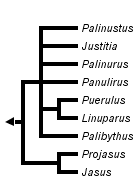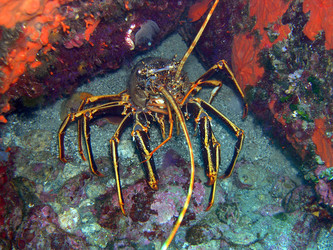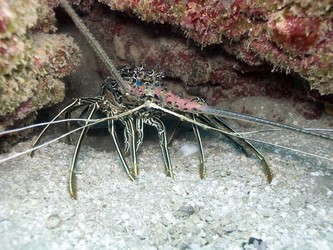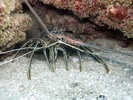Palinuridae
Spiny Lobsters
Sheila Patek


This tree diagram shows the relationships between several groups of organisms.
The root of the current tree connects the organisms featured in this tree to their containing group and the rest of the Tree of Life. The basal branching point in the tree represents the ancestor of the other groups in the tree. This ancestor diversified over time into several descendent subgroups, which are represented as internal nodes and terminal taxa to the right.

You can click on the root to travel down the Tree of Life all the way to the root of all Life, and you can click on the names of descendent subgroups to travel up the Tree of Life all the way to individual species.
For more information on ToL tree formatting, please see Interpreting the Tree or Classification. To learn more about phylogenetic trees, please visit our Phylogenetic Biology pages.
close boxTree adapted from Patek & Oakley (2003). Genus-level relationships remain unresolved with morphological and molecular datasets; only relatively robust branching patterns are shown here.
Introduction
The members of the family Palinuridae are commonly known as spiny lobsters, crawfish/crayfish, langoustes, or shrimp depending on the part of the world in which they are found (Holthuis, 1991). They form a world-wide fishing industry and are found from cold, deep waters up into shallow coral reefs. Palinurids have spiny antennae, lack claws and most species produce loud sounds using structures at the base their antennae.
Discussion of Phylogenetic Relationships
The phylogeny of spiny lobsters (Palinuridae) received its first major analysis in the classic paper by R. George and A. Main (1967). While this study was not a cladistic analysis, it painted an important portrait of the relationships and key characters of both fossil and extant spiny lobsters. A major character in this group is the presence of a sound-producing structure at the base of the antennae; the group was split into sound-producing taxa (Stridentes) and the remaining taxa without an acoustic mechanism (Silentes: Jasus , Projasus). Updated in 1997 (George, 1997) and followed by several other non-cladistic phylogenetic studies (Baisre, 1994; McWilliam, 1995), the phylogeny of the Palinuridae was finally tackled with molecular data and cladistic tools with the analysis of relationships within the genus Jasus (Ovenden et. al. 1997). Subsequently, the relationships within the genus Panulirus (Ptacek et al., 2001) and within and across palinurid genera (Patek & Oakley, 2003) were analyzed using both molecular and morphological data (reviewed in, Patek et al., 2006). Palinurid genera are consistently monophyletic, but the relationships among the genera remain uncertain (Patek & Oakley, 2003; Patek et al, 2006). The most consistent relationships are among the species within the genus Jasus with J. verreauxi at the base of this clade (Ovenden et al. 1997; Patek & Oakley, 2003), and between two large groupings within the genus Panulirus (McWilliam, 1995; Ptacek et al., 2001; Patek & Oakley, 2003).
References
Baisre, J. A. 1994. Phyllosoma larvae and the phylogeny of the Palinuroidea (Crustacea: Decapoda): a review. Australian Journal of Marine and Freshwater Research 45:925-944.
Berry, P. F., and A. E. F. Heydorn. 1970. A comparison of the spermatophoric masses and mechanisms of fertilization in Southern African spiny lobsters (Palinuridae). South African Association for Marine Biological Research Investigational Report No. 25:2-18.
Brasher, D. J., J. R. Ovenden, J. D. Booth, and R. W. G. White. 1992a. Genetic subdivision of Australian and New Zealand populations of Jasus verreauxi (Decapoda: Palinuridae) - preliminary evidence from the mitochondrial genome. New Zealand Journal of Marine and Freshwater Research 26:53-58.
Brasher, D. J., J. R. Ovendon, and R. W. G. White. 1992b. Mitochondrial DNA variation and phylogenetic relationships of Jasus spp. (Decapoda: Palinuridae). Journal of Zoology, London 227:1-16.
George, R. 2006. Tethys sea fragmentation and speciation of Panulirus spiny lobsters. Crustaceana 78:1281-1309.
George, R. W. 1997. Tectonic plate movements and the evolution of Jasus and Panulirus spiny lobsters (Palinuridae). Marine and Freshwater Research 48:1121-1130.
George, R. W. 2005a. Evolution of life cycles, including migration, in spiny lobsters (Palinuridae). New Zealand Journal of Marine and Freshwater Research 39:503-514.
George, R. W. 2005b. Reproductive structures in Panulirus. New Zealand Journal of Marine and Freshwater Research 39:493-501.
George, R. W., and A. R. Main. 1967. The evolution of spiny lobsters (Palinuridae): a study of evolution in the marine environment. Evolution 21:803-820.
George, R. W. 2005. Comparative morphology and evolution of the reproductive structures in spiny lobsters, Panulirus. New Zealand Journal of Marine and Freshwater Research 39:493-501.
Holthuis, L. B. 1991. Marine lobsters of the world. Food and Agriculture Organization of the United Nations, Rome.
McWilliam, P. S. 1995. Evolution of the phyllosoma and puerulus phases of the spiny lobster genus Panulirus White. Journal of Crustacean Biology 15:542-557.
Meyer-Rochow, V. B., and J. D. Penrose. 1974. Sound production and sound emission apparatus in puerulus and postpuerulus of the western rock lobster. Journal of Experimental Zoology 189:283-289.
Moulton, J. 1957. Sound production in the spiny lobster Panulirus argus (Latreille). Biological Bulletin 113:286-295.
Mulligan, B. E., and R. B. Fischer. 1977. Sounds and behavior of the spiny lobster Panulirus argus. Crustaceana 32:185-199.
Ovenden, J. R., J. D. Booth, and A. J. Smolenski. 1997. Mitochondrial DNA phylogeny of red and green rock lobsters (genus Jasus). Marine and Freshwater Research 48:1131-1136.
Ovenden, J. R., D. J. Brasher, and R. W. G. White. 1992. Mitochondrial DNA analyses of red rock lobster Jasus edwarsii supports an apparent absence of population subdivision throughout Australasia. Marine Biology 112:319-326.
Parker, T. J. 1878. Note on the stridulation organ of Panulirus vulgaris. Proceedings of the Zoological Society of London 1878:442-444.
Parker, T. J. 1883. On the structure of the head in Palinurus with special reference to the classification of the genus. Nature 29:189-190.
Patek, S. N. 2001. Spiny lobsters stick and slip to make sound. Nature 411:153-154.
Patek, S. N., R. M. Feldmann, M. Porter, and D. Tshudy. 2006. Phylogeny and evolution of lobstersin Lobsters: Biology, Management, Aquaculture and Fisheries (B. F. Phillips, ed.) Blackwell Publishing, Ames, Iowa.
Patek, S. N., and T. H. Oakley. 2003. Comparative tests of evolutionary tradeoffs in a palinurid lobster acoustic system. Evolution 57:2082-2100.
Pollock, D. E. 1990. Palaeoceanography and speciation in the spiny lobster genus Jasus. Bulletin of Marine Science 46:387-405.
Pollock, D. E. 1992. Palaeoceanography and speciation in the spiny lobster genus Panulirus in the Indo-Pacific. Bulletin of Marine Science 51:135-146.
Pollock, D. E. 1993. Speciation in spiny lobsters - clues to climatically-induced changes in ocean circulation patterns. Bulletin of Marine Science 53:937-944.
Pollock, D. E. 1995. Evolution of life-history patterns in three genera of spiny lobsters. Bulletin of Marine Science 57:516-526.
Ptacek, M. B., S. K. Sarver, M. J. Childress, and W. F. Herrnkind. 2001. Molecular phylogeny of the spiny lobster genus Panulirus (Decapoda: Palinuridae). Marine and Freshwater Research 52:1037-1047.
Ravago, R. G., and M. A. Juinio-Meņez. 2002. Phylogenetic position of the striped-legged forms of Panulirus longipes (A. Milne-Edwards, 1868) (Decapoda, Palinuridae) inferred from mitochondrial DNA sequences. Crustaceana 75:1047-1059.
Sarver, S., J. Silberman, and P. Walsh. 1998. Mitochondrial DNA sequence evidence supporting the recognition of two subspecies or species of the Florida spiny lobster Panulirus argus. Journal of Crustacean Biology 18:177-186.
Title Illustrations

| Scientific Name | Palinurus elephas |
|---|---|
| Location | Columbretes Islands, Spain |
| Specimen Condition | Live Specimen |
| Source | Common Spiny Lobster (Columbretes Islands, Spain) |
| Source Collection | Flickr |
| Image Use |
 This media file is licensed under the Creative Commons Attribution-NonCommercial-NoDerivs License - Version 2.0. This media file is licensed under the Creative Commons Attribution-NonCommercial-NoDerivs License - Version 2.0.
|
| Copyright | © 2004 alfonsator |
| Scientific Name | Panulirus penicillatus |
|---|---|
| Location | Madang, Papua New Guinea |
| Specimen Condition | Live Specimen |
| Source | Lobster (Painted Crafish) - Panulirus penicillatus - PB262002 |
| Source Collection | Flickr |
| Image Use |
 This media file is licensed under the Creative Commons Attribution-NonCommercial-NoDerivs License - Version 2.0. This media file is licensed under the Creative Commons Attribution-NonCommercial-NoDerivs License - Version 2.0.
|
| Copyright | © 2006 Jan Messersmith |
About This Page

University of California, Berkeley, California, USA
Correspondence regarding this page should be directed to Sheila Patek at
Page copyright © 2010
All Rights Reserved.
- First online 09 November 2007
- Content changed 09 November 2007
Citing this page:
Patek, Sheila. 2007. Palinuridae. Spiny Lobsters. Version 09 November 2007 (under construction). http://tolweb.org/Palinuridae/72683/2007.11.09 in The Tree of Life Web Project, http://tolweb.org/









 Go to quick links
Go to quick search
Go to navigation for this section of the ToL site
Go to detailed links for the ToL site
Go to quick links
Go to quick search
Go to navigation for this section of the ToL site
Go to detailed links for the ToL site